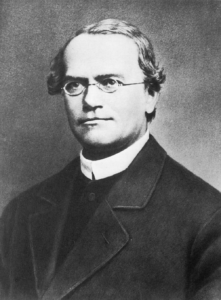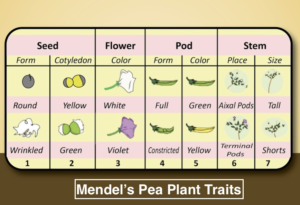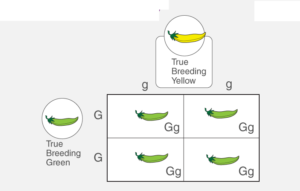

⦿ Genetics is the study of genes, genetic variation, and heredity in living organisms.
⦿ The father of genetics is “Gregor Johan Mendel” a late 19th-century scientist and Augustinian friar.
⦿ Mendel studied “trait inheritance” patterns in the way traits are handed down from parents to offspring.
⦿ The term Genetics was firstly introduced by “William Bateson” in 1906. It has been derived from the Greek word Gene – which means “to become” or “to grow into”.
⦿ Heredity may be defined “as the transmission of traits from one generation to the following generations.
⦿ Heredity and variations which go side by side are the basis of evolution.
⦿ The Austrian monk “Gregor John Mendel” is considered as the Father of “Modern Genetics”. Mendel made experiments on garden pea plants, species of Lathyrus (Pisum sativum).
⦿ He presented or published the first report of his work in 1865 in the Annual Proceedings of “Brunn Society for the Study of Natural Science”.
⦿ He conducted a number of experiments with pea plant in the kitchen garden of the parish.
⦿ He observed several contrasting characters in pea plants such as a tall variety and a dwarf variety, yellow seeds and green seeds, round seeds and wrinkled seeds.
⦿ These characters were handed down from generation to generation because the pea plants are self-pollinated.
The Seven contrasting characters that were taken into account by Mendel are as follow:-
Seed shape – Round or wrinkled
Cotyledon color – Yellow or green
Seed coat color – Colored or white
Pod shape – Inflated or constricted
Pod color – Green or yellow
Flower position – Axial or terminal
Height – Tall or dwarf

Mendel’s Laws of Inheritance
1. Law of Dominance
2. Law of Segregation
3. Law of Independent Assortment
4. Law of Recombination
Law of Dominance
⦿ In monohybrid crosses, he observed that F1 offspring or monohybrids show characters or traits
of only one parent.
⦿ Out of two contrasting characters only one appears in the F1 generation and the other disappears.
⦿ The Law of Dominance, which states that “One character or factor prevents the expression of other”.
⦿ The characters which appear in the F1 generation are called dominant and those which do not appear are termed as recessive.
⦿ This appearance of the dominant character in the F1 generation is termed as the law of dominance.
⦿ Mendel crossed pure tall plants with the pure dwarf plants.
⦿The seeds thus obtained were sown which gave rise to tall plants.
⦿ Thus in F1 generation, only the tall (Tt – Dominant, hybrid) character appears which prevented the expression of the dwarf (tt – Recessive) character.

LAW OF SEGREGATION
⦿ Law of segregation is based on the results and observations of the F2 generations of the monohybrid crosses.
⦿ Mendel experimented further and self-fertilized the flowers of F1 plants or generation.
⦿ The seeds thus obtained from these flowers were sown and developed into plants (F2).
⦿ Mendel noted that all these plants were similar to the original plants i.e. P1 generation and F1 plants.
⦿ They were found to be in a ratio of 3 : 1 (3 plants showing dominant character and 1 showing recessive character).
⦿ This led Mendel to formulate his second law which is called as “Law of Segregation: or “Law of Purity of Gametes.
Law of Independent Assortment
⦿ After monohybrid experiments Mendel tried dihybrid crosses.
⦿ Mendel crossed plants that differed in two characters.
⦿ He crossed pea plant having yellow round seeds with the plant having green wrinkled seeds.
⦿ In F1 generation he obtained dihybrid which had yellow and round seeds (dominant hybrid).
⦿ But when he self-fertilized the plants developed by these seeds of F1, he did not find 3 : 1 ratio as was found in the monohybrid experiments.
⦿ But in F2 generation he found four types of seeds in the ratio of 9 : 3 : 3 : 1. Out of four types of seeds, two types of seeds were like the original parents (P1 generation) but two types quite new.
⦿ By the observations of the dihybrid experiments, Mendel formulated his third law of Independent Assortment.
⦿ Mendel explained that the two characters (seed color and seed shape) are not tied together but they remain independent of each other.
⦿ The round shape of the seed is not always associated with the yellow color; however, it may remain associated with the green color also.
LAW OF RECOMBINATION
⦿ It is the fourth law of inheritance which states: “Various stable characters appearing in several generations of organisms are determined by an association (combination) of different heredity factors (genes).
⦿ These factors undergo reshuffling according to the law of chance.
⦿ This reshuffling produces as many combinations as are mathematically possible.
⦿ Various possible combinations will result in the expression of various stable characters”.
Linkage
⦿ In 1906 Bateson and Punnet reported the first exception to Mendel’s law of independent assortment.
⦿ Found that independent assortment of genes does not take place always because a large number of genes located on the chromosomes are tied together (linked together) and they pass together from generation to generation.
⦿ This tendency of genes to pass on to the next generation in groups is known as linkage
⦿ The phenomenon of linkage was discovered by T. H. Morgan in 1911 in Drosophila melanogaster. T. H. Morgan also proposed the “Theory of Linkage” in 1911.
⦿ According to the “Chromosome Theory of Inheritance” proposed by Walters S. Sutton (1903), the genes are located in the chromosomes
⦿ Each pair of chromosome contains several genes.
⦿ This phenomenon of inheritance of genes together and to retain their parental combination even in the offsprings is known as linkage.